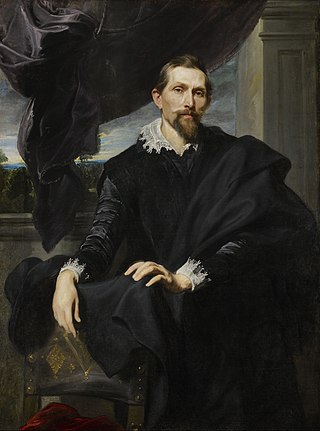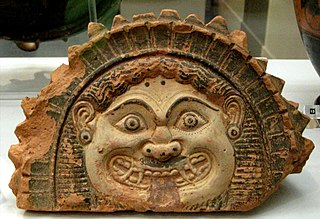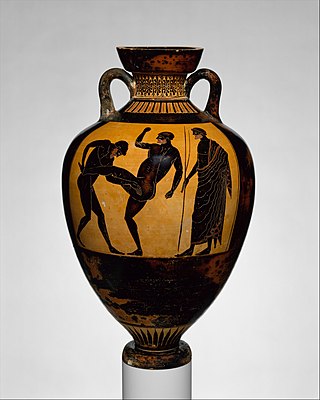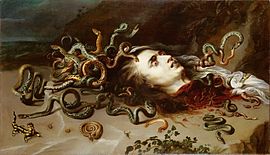
The amphisbaena is a mythological, ant-eating serpent with a head at each end. The creature is alternatively called the amphisbaina, amphisbene, amphisboena, amphisbona, amphista, amfivena, amphivena, or anphivena, and is also known as the "Mother of Ants". Its name comes from the Greek words amphis, meaning "both ways", and bainein, meaning "to go".
The serpent, or snake, is one of the oldest and most widespread mythological symbols. The word is derived from Latin serpens, a crawling animal or snake. Snakes have been associated with some of the oldest rituals known to humankind and represent dual expression of good and evil.

In Greek mythology, Perseus is the legendary founder of the Perseid dynasty. He was, alongside Cadmus and Bellerophon, the greatest Greek hero and slayer of monsters before the days of Heracles. He beheaded the Gorgon Medusa for Polydectes and saved Andromeda from the sea monster Cetus. He was the son of Zeus and the mortal Danaë, as well as the half-brother and great-grandfather of Heracles.

Frans Snyders or Frans Snijders was a Flemish painter of animals, hunting scenes, market scenes, and still lifes. A versatile artist, his works depict all sorts of foods, utensils and tableware and wide assortment of animals. He was one of the earliest specialist animaliers and he is credited with initiating a wide variety of new still-life and animal subjects in Antwerp. His hunting scenes and still lifes engage the viewer with their dramatic and dynamic effects. He was a regular collaborator with leading Antwerp painters such as Peter Paul Rubens, Anthony van Dyck, Jacob Jordaens and Abraham Janssens.

In Greek mythology, Medusa, also called Gorgo or the Gorgon, was one of the three Gorgons. Medusa is generally described as a woman with living snakes in place of hair; her appearance was so hideous that anyone who looked upon her was turned to stone. Medusa and her Gorgon sisters Euryale and Stheno were usually described as daughters of Phorcys and Ceto; of the three, only Medusa was mortal.

The Gemäldegalerie is an art museum in Berlin, Germany, and the museum where the main selection of paintings belonging to the Berlin State Museums is displayed. It was first opened in 1830, and the current building was completed in 1998. It is located in the Kulturforum museum district west of Potsdamer Platz.

Two versions of Medusa were created by Michelangelo Merisi da Caravaggio, one in 1596 and the other in ca. 1597. Both depict the moment from Greek mythology in which the Gorgon Medusa is killed by the demigod Perseus, but the Medusas are also self-portraits. Due to its bizarre and intricate design, the painting is said to display Caravaggio's unique fascination with violence and realism. The Medusa was commissioned by the Italian diplomat Francesco Maria del Monte, who planned to gift the commemorative shield to Ferdinando I de' Medici and have it placed in the Medici collection. It is now located in the Uffizi Museum in Florence without signature.

Cornelis de Vos was a Flemish painter, draughtsman and art dealer. He was one of the leading portrait painters in Antwerp and is best known for his sensitive portraits, in particular of children and families. He was also successful in other genres including history, religious and genre painting. He was a regular collaborator with Rubens.

Snakes are a common occurrence in myths for a multitude of cultures. The Hopi people of North America viewed snakes as symbols of healing, transformation, and fertility. Snakes in Mexican folk culture tell about the fear of the snake to the pregnant women where the snake attacks the umbilical cord. The Great Goddess often had snakes as her familiars—sometimes twining around her sacred staff, as in ancient Crete—and they were worshipped as guardians of her mysteries of birth and regeneration. Although not entirely a snake, the plumed serpent, Quetzalcoatl, in Mesoamerican culture, particularly Mayan and Aztec, held a multitude of roles as a deity. He was viewed as a twin entity which embodied that of god and man and equally man and serpent, yet was closely associated with fertility. In ancient Aztec mythology, Quetzalcoatl was the son of the fertility earth goddess, Cihuacoatl, and cloud serpent and hunting god, Maxicoat. His roles took the form of everything from bringer of morning winds and bright daylight for healthy crops, to a sea god capable of bringing on great floods. As shown in the images there are images of the sky serpent with its tail in its mouth, it is believed to be a reverence to the sun, for which Quetzalcoatl was also closely linked.

The Honeysuckle Bower is a self-portrait of the Flemish Baroque painter Peter Paul Rubens and his first wife Isabella Brant, executed c. 1609.The couple is seated in fine clothes within a garden composition and a vine of honeysuckle is placed overhead. The symbolism of the double-portrait alludes to meanings of love and marriage, such as the holding of right hands, and the concept of the garden of love. The pose of the two figures and their fine clothing signify self-fashioning by Rubens. They wed in 1609, the same year that work was created; it was ultimately given to Isabella’s father Jan Brant and would later end up in the collection of Johann Wilhem II of Düsseldorf. The couple would be married for seventeen years, and have three children before Isabella died in 1625. Her death would have a profound impact on Rubens and through his loss he created an posthumous portrait.

In Greek mythology and ancient religion, Nike is the goddess who personifies victory in any field including art, music, war, and athletics. She is often portrayed in Greek art as "Winged Victory" in the motion of flight; however, she can also appear without wings as "Wingless Victory" when she is being portrayed as an attribute of another deity such as Athena.

The three Gorgon sisters-Stheno, Euryale, and Medusa-are mythological monsters who have been featured in art and culture spanning from the days of ancient Greece to present day. Medusa is the most well-known Gorgon, having been variously portrayed as a monster, a protective symbol, a rallying symbol for liberty, and a sympathetic victim of rape and/or a curse.

The Marie de' Medici Cycle is a series of twenty-four paintings by Peter Paul Rubens commissioned by Marie de' Medici, widow of Henry IV of France, for the Luxembourg Palace in Paris. Rubens received the commission in the autumn of 1621. After negotiating the terms of the contract in early 1622, the project was to be completed within two years, coinciding with the marriage of Marie's daughter, Henrietta Maria. Twenty-one of the paintings depict Marie's own struggles and triumphs in life. The remaining three are portraits of herself and her parents. The paintings now hang in the Louvre in Paris.

Flemish Baroque painting was a style of painting in the Southern Netherlands during Spanish control in the 16th and 17th centuries. The period roughly begins when the Dutch Republic was split from the Habsburg Spain regions to the south with the Spanish recapturing of Antwerp in 1585 and goes until about 1700, when Spanish Habsburg authority ended with the death of King Charles II. Antwerp, home to the prominent artists Peter Paul Rubens, Anthony van Dyck, and Jacob Jordaens, was the artistic nexus, while other notable cities include Brussels and Ghent.

Magdalene with the Smoking Flame is a c. 1640 oil-on-canvas depiction of Mary Magdalene by French Baroque painter Georges de La Tour. Two versions of this painting exist, one in the Los Angeles County Museum of Art and the other in the Louvre Museum.

Prometheus Bound is an oil painting by Peter Paul Rubens, a Flemish Baroque artist from Antwerp. Influenced by the Greek play, Prometheus: The Friend of Man, Peter Paul Rubens completed this painting in his studio with collaboration from Frans Snyders, who rendered the eagle. It remained in his possession from 1612 to 1618, when it was traded in a group of paintings completed by Rubens, to Englishman Sir Dudley Carleton in exchange for his collection of classical statues. This work is currently in the collection of the Philadelphia Museum of Art.

Esther Before Ahasuerus is a painting by the 17th-century Italian artist Artemisia Gentileschi. It shows the biblical heroine Esther going before Ahasuerus to beg him to spare her people. The painting is now in the Metropolitan Museum of Art in New York, having been donated to the museum by Elinor Dorrance Ingersoll in 1969. It is one of Gentileschi's lesser known works, but her use of lighting, characterization, and style help in successfully portraying Esther as a biblical heroine as well as the main protagonist of the work.

Mother and Child (The Oval Mirror) is an oil-on-canvas painting by the American Impressionist artist Mary Cassatt. The painting depicts a mother and her child in front of a mirror. The painting provides a glimpse of the domestic life of a mother and her child, evoking religious iconography from the Italian Renaissance. However, portrayals of a mother and her child are common in Cassatt's work, so it is possible that this similarity is coincidental rather than intentional.

The Kleophrades Panathenaic prize amphora is an Archaic period amphora by the Kleophrades Painter from the collection of the Metropolitan Museum of Art. Dating to c. 500 BCE, the amphora, filled with olive oil, was the prize for a victor in the Panathenaia games in Athens. This particular amphora is a neck amphora that stands at 63.5 centimetres (25.0 in) tall.

In 1635, Peter Paul Rubens created Venus and Adonis, now in the Metropolitan Museum of Art, New York. He followed the mythological story in the Metamorphoses by Ovid, inspired from his love of classical literature and earlier depictions of this scene. This oil on canvas painting shows Venus accompanied by Cupid, embracing and pulling Adonis before he goes off to hunt. The artist uses specific colors, detail and strong contrast between light and dark to depict a dramatic and emotional scene. At the time Rubens created the painting, the mythological story of Venus and Adonis was popular in Renaissance and Baroque court art. Rubens was clearly inspired by the many existing depictions of this scene, in particular the famous Titian composition of the same name, of which there are numerous versions. This depicts the same moment of Adonis leaving Venus to hunt, despite her pleas to stay. He is killed later in the day.



















